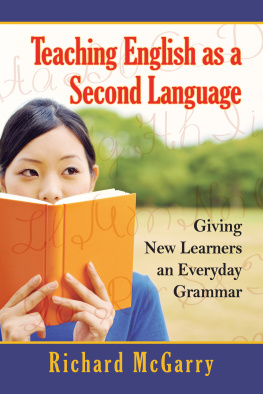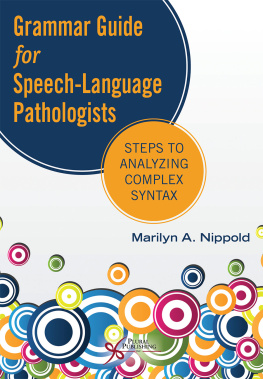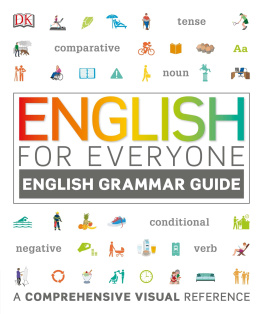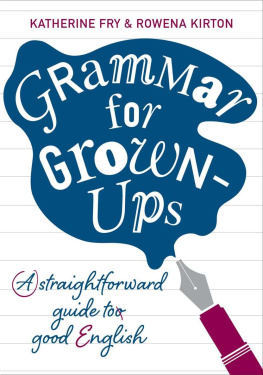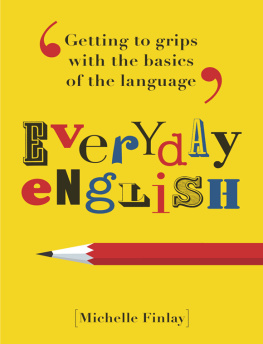Teaching English as a Second Language
Giving New Learners an Everyday Grammar
RICHARD MCGARRY

McFarland & Company, Inc., Publishers
Jefferson, North Carolina
LIBRARY OF CONGRESS CATALOGUING DATA ARE AVAILABLE
BRITISH LIBRARY CATALOGUING DATA ARE AVAILABLE
e-ISBN: 978-0-7864-9146-9
2012 Richard McGarry. All rights reserved
No part of this book may be reproduced or transmitted in any form or by any means, electronic or mechanical, including photocopying or recording, or by any information storage and retrieval system, without permission in writing from the publisher.
Front cover images 2012 Shutterstock
McFarland & Company, Inc., Publishers
Box 611, Jefferson, North Carolina 28640
www.mcfarlandpub.com
This book is dedicated with love
to Carter Hammett-McGarry
Acknowledgments
I would like to acknowledge the valuable contributions of the following people:
An overwhelming debt of gratitude goes to my wife Carter, who is a fine linguist in her own right. I am supremely grateful for her patience, her valuable insights and her suggestions when I hadnt the slightest idea how to proceed.
This text would have never been possible without the students in the English for Internationals class both present and past who have been patient with my ramblings and receptive to the morsels, however meager, I have tossed their way. I am often impressed by their insightful comments and their timely questions. Truly, they have enabled me to see the world and language as complex phenomena. But most importantly, they have enabled me to see out when I have become mired in the hollers of my own narrowness.
I also want to thank the students in my Structure of Modern English class now and in the past who have patiently tolerated my sometimes obscure questions and equally confusing explanations about the state of common-usage English grammar. I am very grateful for their valuable feedback in the development of this text, and for their constant skepticism of my theories, a skepticism that kept me searching for answers to my own questions of why.
A sincere, from the bottom of my heart, thank you goes to my good friend and colleague, Dr. William Wilson, musician and ESL teacher par excellence, who one fateful day in the fall of 2004, happened to be teaching the Intermezzo to Cavalleria Rusticana by Mascagni and helped coin and elucidate the Mascagni Effect, and who waded through this text with patience and good ideas.
I am grateful to my colleagues in the Department of Physiology and Neuroscience at the Medical University of South Carolina for their insights and suggestions on the neuroscience sections of this text.
Finally, the Hubbard Center for Faculty Support and Development at Appalachian State University for their financial and editorial support. Specifically, I would like to thank Ms. Kathy Isaacs, who was a supportive voice throughout the entire process. And I would be remiss if I did not extend my most heartfelt merci to my students at the Universit dAngers in France. They are most marvelous students and even better teachers.
Preface
Few days go by in my working life as a professor of English for international students when one or more (usually more) of my students asks me why certain things are the way they are in the grammar of English. My first inclination upon getting a real mind-bender of a question that I have no clue how to answer is to shrug in all sincerity and say, Beats me! or Well! Thats just the way the language works, or It sounds better that way. Sometimes I get the urge to explain my non-answer by hiding my ignorance in neurolinguistic-cum-philosophical psychobabble. My eyes stare reflectively into some distant space. And, after a few thoughtful moments of reflection, I say something to the effect of: My experience with English, as your experience with your language, is so ingrained in my mind that it has become automatic. I never have to think about using a passive versus an active or the past perfect versus a simple past. I never have to think about which article to use. I just do it! That satisfies them for the few seconds it takes to furrow their brows, cock their heads to one side, and scrunch their lips as if to say, What kind of linguistic-cum-philosophical psychobabble is that, anyway? It would have been better if you had said, Its because the sky is a nice shade of Carolina blue, and the grass is greener on the other side.
And so, after many years of perfecting the art of the reflective far-off stare and the deep linguistic responses that spring from it, my old age and deepened maturity have taught me to refrain from such answers because they do sound like empty-headed psycho-goop. Aside from that, they are rather patronizing. But most important, those who have thought about the confounded nature of English grammar, and have taken the time to formulate a thoughtful question, are actually interested in knowing the answer, even if my response is about as precise as a mountain landscape in an early-morning fog. But I have grown quite fond of the questions, not because it provides me with the opportunity to say something profound, but because the questions are, more times than not, insightful, and because, again more times than not, they strike at the heart of how our language and our culture interact. And given an appropriate and thoughtful answer that is not too laden with gobbledygook, I just might be able to help them (and me) understand how difficult English is sometimes, especially given the variety of contexts in which they find themselves on a regular basis, especially the ones firmly ensconced in and around my home university in the southern Appalachian Mountains. I have a great appreciation for these questions, and those who ask them, because they seem to lie at the heart of how people acquire language, or at least I think so.
Students ask run-of-the-mill questions like, What is the difference between can and may? Sometimes they ask mindbenders like, What does the perfect tense mean and when do you use it? Do you have a subjunctive in English like we do in Spanish? What does it look like and when do you use it? On the surface, such questions seem to have strict formulaic answers. However, for many speakers of American English, it is not so cut and dried at all. The beauty of reflecting on questions like these is that they unlock some of the secrets of who we are as a speech community, and wider, as a culture. They reflect a bit about our history as an immigrant people from many lands far and wide. More importantly, they permit me as a teacher to gain a bit of insight into how my students are undertaking the complex task of learning English, what hypotheses they are making about the language, and how they are resolving their hypotheses with real-life contextualized English. Besides that, these questions are fun to ponder.
My research for this book would not have been possible without the inquisitive students in my English for internationals classes. For two decades now, they have provided me with why-questions in the contexts of numerous real-world conversations with native speakers from a variety of dialects. They have sent me searching for answers which, in some cases, still evade me. But, in turn, they have provided me with many a eureka moment, in which case I have gained a better understanding of how my native language interacts in my native culture. This serves as the rationale for this handbook. Within the text, I offer numerous salient examples from my years in teaching that class. These examples will usually be expressed in the first person.

